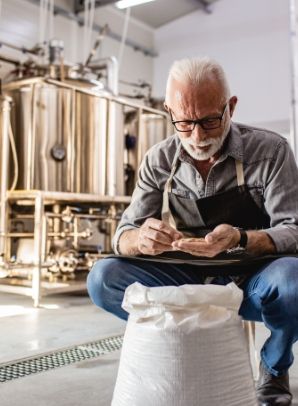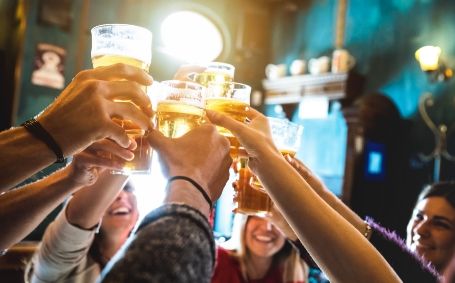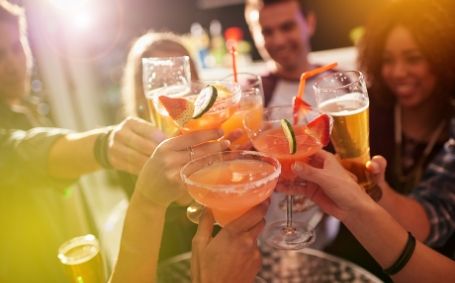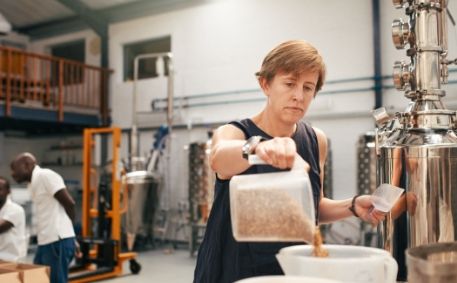How is beer made?
How is beer made?
Helping people make informed choices about alcohol.


How is beer made?

GRAINS AND WATER
Brewing beer is an art. In order to make an alcoholic beverage, some form of fermentable sugar is needed. Unlike wine, which uses crushed grapes for fermentable sugar, beer gets its fermentable sugar by using cereal grain (e.g. malted barley, wheat or sorghum) or some combination of grains. The type(s) of grain used will produce different flavours.
Turning grain into fermentable sugar requires skill. The grain is soaked in water, germinated and then dried in a kiln to become ’malt’. The length of time and temperature at which grain is dried determines its colour and flavour. The malted grain is milled to gently break open the kernel (also known as ’grist’).
Our brewmasters mix the grist with hot water in a process called 'mashing'. This activates enzymes in the malt, which convert the naturally occurring starch in the malt into sugar. The mash is then filtered, leaving a fermentable, sugar-laden liquid called ’wort’.
Up to the last grain!
The grains filtered from the mash are used by farmers as animal feed!

HOPS
Hops are added to the wort and boiled (or ‘brewed’) in a brew kettle. Hops are vines whose cone-like flowers, or cones, give beer its bitter flavour and aroma. The hops also help preserve beer. Boiling is also important to sterilise and stabilise the wort, and to develop colour and flavour. At the end of the boil period, the wort is cooled so yeast can be added.
Hops = salt?
Using hops is like using salt – only a tiny amount is needed!

YEAST
Similar to baking bread, yeast is critical to making beer. Yeast is added to the wort to turn the sugars into alcohol and carbon dioxide in a process called fermentation.
We're careful about the quality of the yeast we use – it affects how well fermentation works, as well as the quality of the beer's flavour.
After fermentation, the beer is aged in tanks or casks. We then filter the beer to remove small particles of yeast or protein that might make it cloudy. The beer is then ready to be put into bottles, cans and kegs.
Did you know?
The amount of yeast grows about three-fold during fermentation
SO WHAT EXACTLY IS BEER?
'Beer' is the name used to describe the family of alcoholic beverages brewed from malt and flavoured with hops.
There are two categories of beer: 'Lagers' and 'Ales'. Lagers use yeast that gathers at the bottom of the fermentation tank, while Ales use yeast that gathers at the top.
Ales are also brewed and aged at a higher temperature than lagers to produce a different flavour profile.
AND WHAT ABOUT NON-ALCOHOLIC BEER?
Non-alcoholic beers are brewed very much like normal beer, using the same basic ingredients – cereal grains (e.g. malted barley or wheat), hops, yeast and water. However, at some stage in the process, steps are taken that greatly reduce or eliminate the alcohol in the final product.
There are several methods that can be used to brew non-alcoholic beer. One long-standing practice has been to remove alcohol at the end of the brewing process through evaporation or filtration. In these processes, either heat is used to drive off (evaporate) the alcohol or filtration is used to remove the alcohol during the final stages of the brewing process.
In recent years, a new method called 'restricted alcohol fermentation' has been used. In this process, the production of alcohol during the brewing process is reduced from the very start by using special yeast that produces very little alcohol during the fermentation process. There are other processes as well, but no matter the process, when it is through, these beers should look, smell and taste like traditional beer, but with very little or no alcohol.
Some facts about non-alcoholic beer
Many adults enjoy non-alcoholic beers – and for good reason
Non-alcoholic beers are growing in popularity, giving adults greater choices when it comes to a night out. Once thought to be reserved for people who were pregnant, had health problems, or needed to drive, adults are discovering that non-alcoholic beers offer refreshment any time they want the taste of beer without alcohol.
What are non-alcoholic beers?
These beers look, smell and taste like traditional beer but contain very little or no alcohol. The amount of alcohol contained in a non-alcoholic beer is typically equivalent to the amount of alcohol found in a glass of orange juice. Many consumable products contain trace amounts of alcohol similar to that of non-alcoholic beer (e.g., some soft drinks and Belgian chocolates).
How does a 'non-alcoholic' beer differ from a 'low alcohol' beer?
Traditional beers usually contain around 4%-6% alcohol by volume. Beers that contain very low or no alcohol are referred to and defined differently worldwide, such as 'non-alcoholic,' 'near beer,' 'dealcoholised,' 'low alcohol,' and 'alcohol free.' In some countries it is common to refer to ‘light’ beers as those containing less alcohol, while in other countries 'light' refers to products that have fewer calories.
Non-alcoholic beers contain significantly lower amounts of alcohol than more traditional beer but are often not completely alcohol free.
The legal definitions and the terminology used to describe low and no alcohol beers vary by country. Examples include:
- Australia/New Zealand: any alcoholic beverage that contains more than 1.15% ABV must not be represented as 'low alcohol'
- Canada: alcoholic beverages are defined as containing 1.1% or more ABV
- UK: 'alcohol free' or 'no alcohol' drinks contain no more than 0.05% ABV
- US: fermented beverages of less than 0.5% ABV are not defined as 'beer' but as a 'malt beverage.' 'Alcohol free' refers to a beverage with no detectable alcohol, while 'non-alcoholic' refers to beverages containing less than 0.5%


